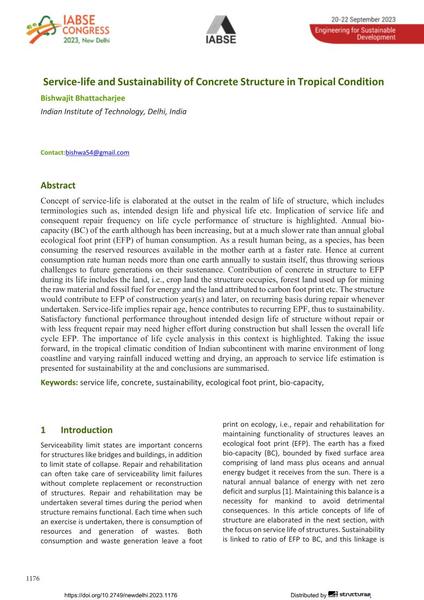Service-life and Sustainability of Concrete Structure in Tropical Condition

|
|
|||||||||||
Bibliographic Details
| Author(s): |
Bishwajit Bhattacharjee
(Indian Institute of Technology, Delhi, India)
|
||||
|---|---|---|---|---|---|
| Medium: | conference paper | ||||
| Language(s): | English | ||||
| Conference: | IABSE Congress: Engineering for Sustainable Development, New Delhi, India, 20-22 September 2023 | ||||
| Published in: | IABSE Congress New Delhi 2023 | ||||
|
|||||
| Page(s): | 1176-1184 | ||||
| Total no. of pages: | 9 | ||||
| DOI: | 10.2749/newdelhi.2023.1176 | ||||
| Abstract: |
Concept of service-life is elaborated at the outset in the realm of life of structure, which includes terminologies such as, intended design life and physical life etc. Implication of service life and consequent repair frequency on life cycle performance of structure is highlighted. Annual bio- capacity (BC) of the earth although has been increasing, but at a much slower rate than annual global ecological foot print (EFP) of human consumption. As a result human being, as a species, has been consuming the reserved resources available in the mother earth at a faster rate. Hence at current consumption rate human needs more than one earth annually to sustain itself, thus throwing serious challenges to future generations on their sustenance. Contribution of concrete in structure to EFP during its life includes the land, i.e., crop land the structure occupies, forest land used up for mining the raw material and fossil fuel for energy and the land attributed to carbon foot print etc. The structure would contribute to EFP of construction year(s) and later, on recurring basis during repair whenever undertaken. Service-life implies repair age, hence contributes to recurring EPF, thus to sustainability. Satisfactory functional performance throughout intended design life of structure without repair or with less frequent repair may need higher effort during construction but shall lessen the overall life cycle EFP. The importance of life cycle analysis in this context is highlighted. Taking the issue forward, in the tropical climatic condition of Indian subcontinent with marine environment of long coastline and varying rainfall induced wetting and drying, an approach to service life estimation is presented for sustainability at the and conclusions are summarised. |
||||
| Keywords: |
concrete sustainability service life ecological foot print bio-capacity
|
||||
